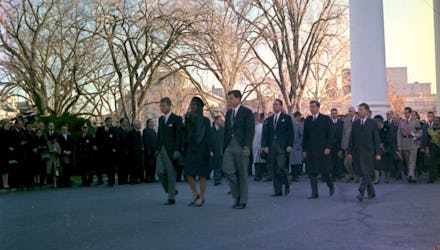The Nobody Who Dug JFK’s Grave, and the Somebody Who Made Him Famous

In journalism school, we didn’t learn about John F. Kennedy. We learned about the man who dug his grave.
There was good reason for it.
Jimmy Breslin, the Pulitzer Prize-winning "curmudgeonly columnist," will go down as one of the greatest newspaper writers of all time. One of his most well-known pieces is his November 1963 New York Herald Tribune column, "Digging JFK Grave Was His Honor," still regarded as one of the most renowned pieces of journalism today.
***
Fifty years ago, Breslin arrived in Washington, D.C., from reporting in Dallas, where Kennedy was shot and killed on Friday, November 22. On Saturday, the president's body was brought home, where it would rest until the Monday service. Thousands of reporters were swarming the White House.
Breslin was one of them, but he had a different idea. He was a step ahead: What was going on at the cemetery?
He'd find the man who was digging the president's grave.
He went to Arlington Cemetery on Sunday.
"Here was this fella, black working man, and he was digging Kennedy’s grave with a backhoe. He made sense of the story for me. By doing a day’s work. Like I should be doing right now," he told New York Daily News.
Thus opens the column.
Clifton Pollard knew he’d be working that Sunday. It was obvious; he was just waiting for the phone call. It would be like any other day — he’d be digging another grave for another man he did not know — except that day, he’d be digging a grave for the murdered president of the United States.
"One of the last to serve John Fitzgerald Kennedy," Breslin wrote in the column, "was a working man who earns $3.01 an hour and said it was an honor to dig the grave."
Pollard, who had served as a private in the 352nd Engineers battalion in World War II, was 42 years old at the time. He repeats throughout Breslin’s piece that it was "an honor" to dig the president's grave.
Then, Breslin skips to Monday, November 25. The day of the funeral. Suddenly, his literary camera pans to a different scene entirely.
He zooms in on Jackie. A glistening icon. An American sensation who, days earlier, had carried her husband’s brains in her bare hands, who did not cry, who ordered that her pink Chanel blood-stained suit never be washed; a woman who calmly told the priest in the hospital room, "Thank you for taking care of the president."
Breslin paints this haunting and captivating scene:
"Yesterday morning, at 11:15, Jacqueline Kennedy started toward the grave. She came out from under the north portico of the White House and slowly followed the body of her husband, which was in a flag-covered coffin that was strapped with two black leather belts to a black caisson that had polished brass axles. She walked straight and her head was high. She walked down the bluestone and blacktop driveway and through shadows thrown by the branches of seven leafless oak trees. She walked slowly past the sailors who held up flags of the states of this country. She walked past silent people who strained to see her and then, seeing her, dropped their heads and put their hands over their eyes. She walked out the northwest gate and into the middle of Pennsylvania Avenue. She walked with tight steps and her head was high and she followed the body of her murdered husband through the streets of Washington.
Everybody watched her while she walked. She is the mother of two fatherless children and she was walking into the history of this country because she was showing everybody who felt old and helpless and without hope that she had this terrible strength that everybody needed so badly. Even though they had killed her husband and his blood ran onto her lap while he died, she could walk through the streets and to his grave and help us all while she walked."
He goes on to describe the stunning and grandiose ceremony in detail — jets flying overhead, leaves falling from the sky, Secret Servicemen praying aloud — and details of minutia that so clearly contrast against the enormity of it all.
(At some point, JFK Jr. saluted his father’s coffin, a moment that was captured and frozen in time for millions to study, marvel at, dissect, and admire. It was the young boy’s third birthday that day.)
Then Breslin departs from the ceremony and returns to Clifton Pollard, who'd been blocked off from watching the funeral and was off digging another grave.
"That’s what was wrong with the country," Breslin told New York Daily News. "Still is. The working guy isn’t good enough to stand with the big shots."
In another interview, he said, "So the big glamorous funeral is being held, and he’s over there digging, lonely … And that’s the story of life too. When there’s something like that going on, think of somebody off in right field who might be very important. The view from the side is very good."
In a mere 1,000 words, Breslin crafts three layers of society. In one remarkable scene: the anonymous nobody digging the grave, the celebrity being buried in it, and Breslin himself, floating somewhere in between.
There are the people who are on the stage, the people who are in the audience, and the people who never get to see the play at all.
***
Twenty-five years later, Pollard was 67 and retired after 33 years of digging graves. He said that it was hard work and honest work that he was proud of.
In April of 1992, someone dug a grave for the gravedigger. Nobody wrote about it.
Breslin is still alive and in his 80s. When the time comes, I’ll be damned if I’m not at that cemetery a day early.